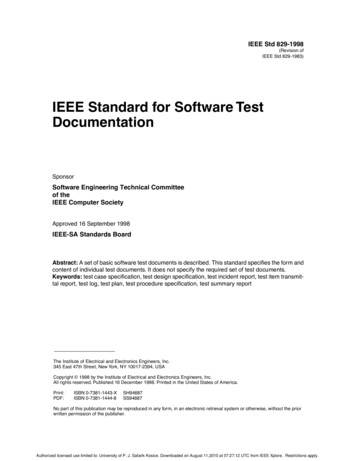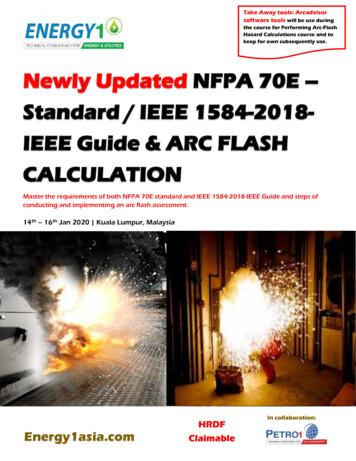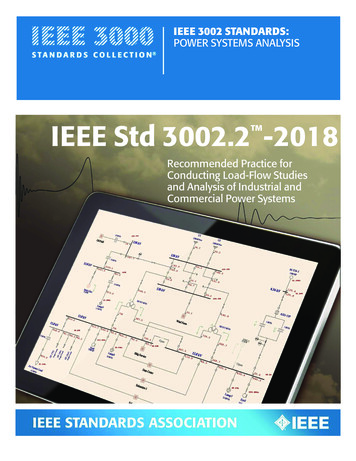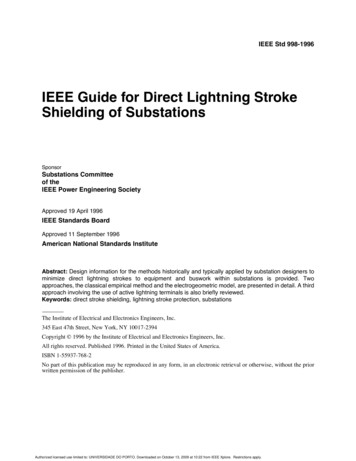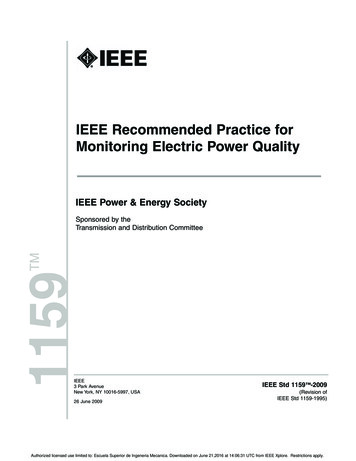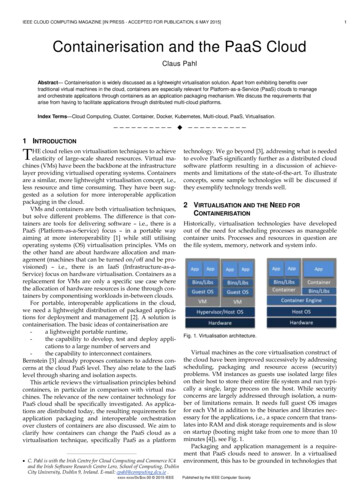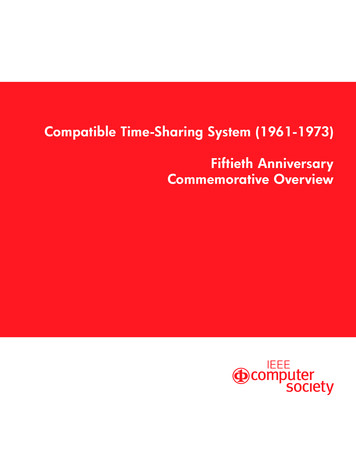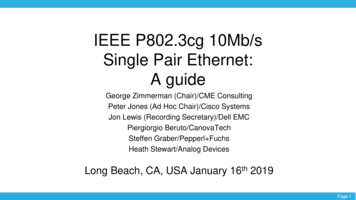
Transcription
IEEE P802.3cg 10Mb/sSingle Pair Ethernet:A guideGeorge Zimmerman (Chair)/CME ConsultingPeter Jones (Ad Hoc Chair)/Cisco SystemsJon Lewis (Recording Secretary)/Dell EMCPiergiorgio Beruto/CanovaTechSteffen Graber/Pepperl FuchsHeath Stewart/Analog DevicesLong Beach, CA, USA January 16th 2019Page 1
Agenda Why 802.3cgWhat’s in 802.3cgMultidrop and PLCAConcerns about PLCAWrap-up and Q&APeter JonesJon LewisGeorge ZimmermanGeorge ZimmermanGeorge, Heath, Jon,Peter, Piergiorgio, SteffenIEEE P802.3cg 10Mb/s Single Pair Ethernet Task Force – Jan 2018 Interim, Long Beach, CA USAPage 2
What is going on with rates? 802.3cg – 10 Mb/s Single Pair(10SPE)– Point-to-point 1km full duplex PHY– Point-to-point 15m PHY Optional full duplex (mandatory half duplex)– Option for half-duplex multidrop - return toCSMA/CD shared-medium networking Supports up to 25m single pair Optional RS (PLCA) to improve performanceunder load. Repeaters are not specified 802.3ch – Multigig Single pair– Point-to-point, automotive-reach (15m)IEEE P802.3cg 10Mb/s Single Pair Ethernet Task Force – Jan 2018 Interim, Long Beach, CA USAPage 3
WHY802.3CGPeter JonesIEEE P802.3cg 10Mb/s Single Pair Ethernet Task Force – Jan 2018 Interim, Long Beach, CA USAPage 4
Industrial Networking Ethernet GapIEEE 802.3 10SPE CFI, July 2016IEEE P802.3cg 10Mb/s Single Pair Ethernet Task Force – Jan 2018 Interim, Long Beach, CA USAPage 5
Target – Fieldbus UpgradesIEEE 802.3 10SPE CFI, July 2016IEEE P802.3cg 10Mb/s Single Pair Ethernet Task Force – Jan 2018 Interim, Long Beach, CA USAPage 6
Target – Fieldbus UpgradesIEEE 802.3 10SPE CFI, July 2016IEEE P802.3cg 10Mb/s Single Pair Ethernet Task Force – Jan 2018 Interim, Long Beach, CA USAPage 7
Automotive Networking Ethernet GapSource: CanovatechIEEE P802.3cg 10Mb/s Single Pair Ethernet Task Force – Jan 2018 Interim, Long Beach, CA USAPage 8
Example use cases Short:– In-cabinet, chassis– Vehicles– Multipoint topologies Medium:– Industrial pods (5-40m)– Building control networks (50-100m)– Process control “spurs” (200m) Long:– Process control trunks (1km)– Building automation trunks (500m) Application drives cabling (e.g., wiregauge)IEEE P802.3cg 10Mb/s Single Pair Ethernet Task Force – Jan 2018 Interim, Long Beach, CA USAPage 9
But wait, there’s more. 10 Mb/s BackplaneEthernet (10BPE) CFIadded intra-system usecases (e.g. servers,switches) Every time I turn around,someone has a new use.––––ElevatorsFire alarm control (SLC)HVAC control and monitor Next Application ETHERNETKey enabling technologyIEEE P802.3cg 10Mb/s Single Pair Ethernet Task Force – Jan 2018 Interim, Long Beach, CA USAPage 10
10SPE for ElevatorsSource: KoneIEEE P802.3cg 10Mb/s Single Pair Ethernet Task Force – Jan 2018 Interim, Long Beach, CA USAPage 11
Example: Control Plane in Servers and Switches10BASE-T1S for control plane in Ethernet switches10Mb/s Backplane Ethernet CFIIEEE P802.3cg 10Mb/s Single Pair Ethernet Task Force – Jan 2018 Interim, Long Beach, CA USAPage 12
WHAT’S IN 802.3CG?Jon LewisIEEE P802.3cg 10Mb/s Single Pair Ethernet Task Force – Jan 2018 Interim, Long Beach, CA USAPage 13
BASE-T1(short reach) FamilySource: CanovatechIEEE P802.3cg 10Mb/s Single Pair Ethernet Task Force – Jan 2018 Interim, Long Beach, CA USAPage 14
802.3cg key characteristics2 single balanced pair PHYs– 10BASE-T1L: Long reach (1km, 18AWG)– 10BASE-T1S: Short reach (15-25m, 24-26AWG) Automotive and industrial conditions Energy efficiency Point to point power (PoDL) Half duplex multidrop (T1S)IEEE P802.3cg 10Mb/s Single Pair Ethernet Task Force – Jan 2018 Interim, Long Beach, CA USAPage 15
Two PHYs 10BASE-T1L: Clause 146, 1km reach– Full-duplex point-to-point– Optional increased transmit level (e.g., increased noise tolerance)– Optional Energy Efficient Ethernet (low power idle) 10BASE-T1S: Clause 147, 15m reach (25m for multidrop)– Half-duplex point-to-point – base level for interoperability– Optional full-duplex point-to-point– Optional half-duplex shared-medium/multidrop using CSMA/CD Optional PLCA RS improves performance under load Optional Clause 98 Auto-NegotiationIEEE P802.3cg 10Mb/s Single Pair Ethernet Task Force – Jan 2018 Interim, Long Beach, CA USAPage 16
10BASE-T1L Basics Simple, echo cancelled, 7.5 MBd full-duplex PHY– No FEC, PAM-3 transmission 1Vpp, 4B3T encoded signal– PCS coding minimizes disparity, keeping signal within voltagebounds (important for industrial applications)– Optional 2.4Vpp transmit amplitude Auto-Negotiated 1000m reach (18AWG cable) “quiet/refresh” EEE (like other BASE-T/BASE-T1 PHYs) Example implementations have been demonstratedIEEE P802.3cg 10Mb/s Single Pair Ethernet Task Force – Jan 2018 Interim, Long Beach, CA USAPage 17
10BASE-T1L ExampleIEEE P802.3cg 10Mb/s Single Pair Ethernet Task Force – Jan 2018 Interim, Long Beach, CA USAPage 18
10BASE-T1S basics Half-duplex or full-duplex point-to-point (15m)– Compatible with PoDL (Clause 104) powering Half-duplex multidrop (8 nodes, 25m)– Multidrop power not defined in 802.3cg 12.5 MBd, 1Vpp, 4B/5B encoded DME signal– DME coding enables low cost and multidrop– No FEC Idle-less DME efficiency means EEE not required Example implementations have been demonstrated– See, e.g., http://www.ieee802.org/3/cg/public/adhoc/Widger 3cg 01 0918.pdfIEEE P802.3cg 10Mb/s Single Pair Ethernet Task Force – Jan 2018 Interim, Long Beach, CA USAPage 19
BASE-T1 Auto-Negotiation As in BASE-T, Auto-Negotiation is key to broad adoption Enables multi-speed and multi-mode ports (like 10/100/1000BASE-T)– Negotiate link parameters (e.g., 10/100/1000, T1S vs. T1L, loop-timing, EEE)– Capabilities exchanged, use “highest common denominator”– Capabilities advertised may be restricted by “management” BASE-T1 Auto-Negotiation defined in (existing) Clause 98– Not compatible with Clause 28 used for BASE-T– Uses similar structure from Clause 28 (e.g., base pages/next pages)– 60ns clock-to-clock for existing PHYs and T1S T1L adds slower signaling rate (1600ns clock-to-clock) due to link segment bandwidthAUTO-NEGOTIATION ONLY DEFINED FOR POINT-TO-POINTIEEE P802.3cg 10Mb/s Single Pair Ethernet Task Force – Jan 2018 Interim, Long Beach, CA USAPage 20
Auto-Negotiation signaling rate detection Detection of Auto-Negotiationsignaling speed added to Clause 98 Detects partner’s DME rate Enables Auto-Negotiation between10BASE-T1L and other BASE-T1PHYsFigure 98-11IEEE P802.3cg 10Mb/s Single Pair Ethernet Task Force – Jan 2018 Interim, Long Beach, CA USAPage 21
PoDL Power – Clause 104 extension Interoperable extension of PoDL (constant-power system)– Extends loop resistance beyond 6.5 ohms– Optimize delivered power using ‘cable resistance measurement’IEEE P802.3cg 10Mb/s Single Pair Ethernet Task Force – Jan 2018 Interim, Long Beach, CA USAPage 22
MULTIDROP AND PLCARECONCILIATION SUBLAYERGeorge ZimmermanIEEE P802.3cg 10Mb/s Single Pair Ethernet Task Force – Jan 2018 Interim, Long Beach, CA USAPage 23
Multidrop – the ‘mixing segment’ Linear topology w/stubs– Examples dl matheus 3cg 01c 09 2017.pdf– Data kan 3cg 01a 0118.pdf Capacitance limits node ruto 3cg 02 0518.pdf Gauge limits reach Repeaters not specifiedIEEE P802.3cg 10Mb/s Single Pair Ethernet Task Force – Jan 2018 Interim, Long Beach, CA USAPage 24
PLCA RS: notable properties Provides strict packet fairness Requires the half-duplex Clause 4 MAC using CSMA/CD Improves utilization and bounds access latency– Extends current MII definitions using reserved code points, ignored by existing PHYs– Unchanged Clause 4 MAC performs medium allocation and contention resolution Basics:– A single coordinating station regularly transmits a marker (the BEACON)– After each transmitted BEACON, each station is granted a transmit opportunity (TO)– Each station (including the coordinating station): Monitors TOs If it has data to send, a station starts transmission only during its TOIEEE P802.3cg 10Mb/s Single Pair Ethernet Task Force – Jan 2018 Interim, Long Beach, CA USAPage 25
Bandwidth under Load*100% load10.0010.008.008.006.006.00Mb/sMb/s70% load4.004.002.002.000.000.0012345Transmitting NodesCSMA/CD PLCACSMA/CD612345Transmitting NodesCSMA/CD PLCA6CSMA/CD* Simulation example – bandwidth variesIEEE P802.3cg 10Mb/s Single Pair Ethernet Task Force – Jan 2018 Interim, Long Beach, CA USAPage 26
Access Latency under Load*Latency vs Utilization100000Latency (µs)10000100010010203040CSMA/CD MAX* Simulation example – bandwidth varies506070Utilization (percent)CSMA/CD AVGPLCA MAX8090100PLCA AVGIEEE P802.3cg 10Mb/s Single Pair Ethernet Task Force – Jan 2018 Interim, Long Beach, CA USAPage 27
Project Scope Approved PARIEEE Std 802.3-2018, Figure 1-1IEEE P802.3cg 10Mb/s Single Pair Ethernet Task Force – Jan 2018 Interim, Long Beach, CA USAPage 28
Existing MCU using MII and PLCAChip to chip interface,matches physical MIIimplementationExisting MCU IC withEmbedded MACMIIUnexposedMIIMDIExposedMIIMDI10BASE-T1S PHY ICwithout PLCA10BASE-T1S PHY IC withPLCA RSIEEE P802.3cg 10Mb/s Single Pair Ethernet Task Force – Jan 2018 Interim, Long Beach, CA USAPage 29
CONCERNS ABOUT PLCAIEEE P802.3cg 10Mb/s Single Pair Ethernet Task Force – Jan 2018 Interim, Long Beach, CA USAPage 30
Concerns Expressed (two commenters) “PLCA is a MAC – this is a Physical Layer project” “modifying MII breaks compatibility” “management is optional, it doesn’t work withoutmanagement configuration”IEEE P802.3cg 10Mb/s Single Pair Ethernet Task Force – Jan 2018 Interim, Long Beach, CA USAPage 31
Is PLCA a new MAC?Claim: PLCA is a new MACResponse: PLCA does NOT interface at the MAC Service Access Point PLCA does NOT perform MAC functions, only Physical Layer and Reconciliation Sublayer functions IEEE Std. 802.3 Clause 4.1.1 Media Access Control functions:– Data encapsulation (transmit and receive) – PLCA doesn’t do any of these Framing (frame boundary delimitation, frame synchronization) Addressing (handling of source and destination addresses) Error detection (detection of physical medium transmission errors)– Media Access Management - Medium allocation (collision avoidance) PLCA performs normal PHY functions of Collision Detect and Carrier Sense and sends these to the Clause 4 MAC- PLCA does these Physical Layer functions PLCA delays data to align for and enable collision detect- PLCA does this (normal RS function) Clause 4 MAC holds back frames based on CRS and COL- PLCA does not do this Contention resolution (collision handling)- PLCA does not do thisPLCA does not perform MAC hoc/zimmerman 3cgah 01a 100318.pdfIEEE P802.3cg 10Mb/s Single Pair Ethernet Task Force – Jan 2018 Interim, Long Beach, CA USAPage 32
Specified PLCA functions are currently defined asPhysical Layer functions in 802.3 PLCA functions of providing carrier sense and collision detect, and using a variable delay toalign data, are already specified in 802.3-2018 Ethernet as Physical Layer functions Clause 4 is clear – Carrier Sense and Collision Detect are provided by the Physical Layer– 4.1.2.1.1 Transmission without contention (under Normal Operation of CSMA/CD) “In half duplex mode, Transmit Media Access Management attempts to avoid contention with other trafficon the medium by monitoring the carrier sense signal provided by the Physical Layer Signaling (PLS)component and deferring to passing traffic.”– 4.2.3.2.4 Collision detection and enforcement “Collisions are detected by monitoring the collisionDetect signal provided by the Physical Layer.” XGMII-based implementations (and later xMII) already use variable delays for alignmentbetween MAC and PHY timing– 46.3.1.4 Start control character alignment “On transmit, it may be necessary for the RS to modify the length of the inter-frame in order to align theStart control character (first octet of preamble) on lane 0.”– Subsequent RS’s perform alignment similarly (Cl 106 & Cl 81)These functions are within the Physical Layer (including RS)!IEEE P802.3cg 10Mb/s Single Pair Ethernet Task Force – Jan 2018 Interim, Long Beach, CA USAPage 33
Detail: MII compatibility Claim: PLCA violates CSD requirements about MII(http://www.ieee802.org/3/cg/public/Nov2018/Kim 3cg 01 1118.pdf slides #4-6)– “As a PHY amendment to IEEE Std 802.3, the proposed project will use MII ” Response:– PLCA has full MII compatibility– In PHY direction, PLCA RS adds signaling on top of MII in reserved code space(same as EEE did) - No impact on existing PHY specifications: Existing text in 22.2.24: “For EEE capability, the RS shall use the combination ofTX EN deasserted, TX ER asserted, and TXD 3:0 equal to 0001 as shown inTable 22–1 as a request to enter, or remain in a low power state. Other values ofTXD 3:0 with this combination of TX EN and TX ER shall have no effect uponthe PHY “– PHY implementations prior to PLCA introduction ignore the newly addedcombinations! Backward compatibility is preserved, as happened when EEE was introduced.– In MAC direction, PLCA asserts Collision Detect and Carrier Sense – defined inClause 4 to be provided by the Physical LayerIEEE P802.3cg 10Mb/s Single Pair Ethernet Task Force – Jan 2018 Interim, Long Beach, CA USAPage 34
Detail: CL4 MAC compatibility Claim: PLCA is not compatible with existing MAC(http://www.ieee802.org/3/cg/public/Nov2018/Kim 3cg 01 1118.pdf, slide 5) Response:– There are no modifications to the MAC (Clause 4) in 802.3cg draft. Normative part of Clause 4 is specified in the form of Pascal code– The PLCA RS maps between PLS primitives and the MII (see148.4.3)– PLCA implementations have been successfully tested againstexisting MAC /July2018/PLCA%20overview.pdf, slides #19-21)IEEE P802.3cg 10Mb/s Single Pair Ethernet Task Force – Jan 2018 Interim, Long Beach, CA USAPage 35
What about Management?Claim: PLCA is not interoperable because it relies on managementconfiguration which (commenter claims) is 8/Kim 3cg 01 1118.pdf slides #10-12)Response: Is management optional?– MDIO as an electrical interface and register set is optional.– A ubiquitous management entity isn’t optional – in many cases ‘equivalentfunctionality’ needs to be provided if MDIO isn’t present, or there are fall-backdefaults. PLCA requires configuration to give enhanced performance, otherwiseperformance is normal half-duplex CSMA/CD– Interoperable, just not enhanced.IEEE P802.3cg 10Mb/s Single Pair Ethernet Task Force – Jan 2018 Interim, Long Beach, CA USAPage 36
WRAP-UP AND Q&AIEEE P802.3cg 10Mb/s Single Pair Ethernet Task Force – Jan 2018 Interim, Long Beach, CA USAPage 37
802.3cg in a Nutshell Industrial, Automotive, Building & Intra-system 10Mb/s Networking– Optional power and multidrop 2 PHYs, 1 Reconciliation Sublayer, and PoDL extension– Long reach, full duplex 10BASE-T1L – Clause 146 Clause 98 extension (slower speed Auto-Negotiation for 10BASE-T1L)– Short reach, half duplex 10BASE-T1S – Clause 147 Options: full duplex point-to-point, half duplex multidrop– PLCA RS for enhanced multidrop performance – Clause 148 Performs only Physical Layer functions already in 802.3– PoDL extension – Clause 104 More power classes, greater loop resistance, and cable resistancemeasurementIEEE P802.3cg 10Mb/s Single Pair Ethernet Task Force – Jan 2018 Interim, Long Beach, CA USAPage 38
PANEL & Q&AIEEE P802.3cg 10Mb/s Single Pair Ethernet Task Force – Jan 2018 Interim, Long Beach, CA USAPage 39
Thank You!IEEE P802.3cg 10Mb/s Single Pair Ethernet Task Force – Jan 2018 Interim, Long Beach, CA USAPage 40
IEEE P802.3cg 10Mb/s Single Pair Ethernet Task Force –Jan 2018 Interim, Long Beach, CA USA Page 33 Specified PLCA functions are currently defined as Physical Layer functions in 802.3 PLCA functions of providing carrier


